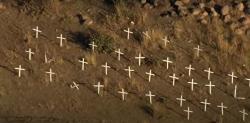By Mark Langabeer, RMT member, personal capacity
This 2014 documentary film, freely available on YouTube, was made by Uhuru Productions and directed by Rehad Desai and gives an account of the massacres of miners in Marikana, South Africa, two years before. Simply entitled, Miners shot down, it describes events that have parallels with the massacres of Sharpsville and Soweto in the apartheid era.
At Marikana, the South African police shot 112 striking miners, leaving 34 dead and this documentary gives a record of the six days which led up to the killing. It firmly points the finger of blame at the company bosses and the ANC leadership.
Strikers demanded pay rises
The strike began in late August with rock drillers at one of the platinum mines owned by Lonmin, a British-based company. The miners earned around 5,000 Rand annually and were demanding a pay rise to R7,000. The programme noted that Lonmin had just expanded its operations and was financially vulnerable to strike action.
Around 3000 miners struck, but without the support of the National Union of Mineworkers, the main union that organised at Lonmin. The union refused to support the action and the leadership was perceived by many miners as being in the pocket of Lonmin’s management.
The South African NUM had played a pivotal role during the days of Apartheid and the union was led by Cyril Ramaphosa, who is the current leader of the ANC and South African President. He is also a director on the board of Lonmin and a major shareholder of the company. Having become a very wealthy man, he now sits on the other side of the table from the miners. As the time of the strike, the management refused to meet representatives of the strikers and threaten to sack them if they continued their action. There were confrontations between the company security guards, supported by police, and the strikers who tried to march to Lonmin’s headquarters to present their demands.
The first confrontation led to nine deaths, which included strikers, security guards and two police officers. One contributor believed that this was a motive for the massacre that took place later. Film footage showed a stand-off between police and around 200 strikers, mostly armed with spears, knifes and clubs.
The police demanded that they surrender their spears, but the strikers offered to give up their weapons only when they had left the company’s land and entered common land, called ‘the Mountain’. The senior officer at the scene had a phone call telling him not to accept the strike leaders demands and in the event, the miners managed to march to the Mountain without any resistance from the police.
Miners hunted down and killed
The role of the South African NUM, whose officials also confronted the strikers, led to the formation of a breakaway union called the Association of Miners and Construction Union, which still exists today, but now with a quarter of a million members. The AMCU, of course, supported the action and so many miners left the NUM.
It was on the sixth day of the strike that around a thousand strikers who had left the Mountain were corralled by police with military armoured vehicles, who then began firing. The strikers were who were not mown down simply fled for their lives.
There were two series of killings, both resulting in 17 dead. One of the scenes in the documentary clearly suggests that miners were being hunted down. It was far more like an execution, than a case of police ‘protecting themselves’. Ambulances were prevented from approaching the scene of the shooting until an hour afterwards. One contributor noted that at the time of the shootings, the strikers hadn’t blockaded any company roads or damaged property.
What came over clearly was a desire on the part of the Lonmin management and Ramaphosa that the police should act more firmly with the striking miners.
Afterwards, there was the ludicrous situation that 270 miners were arrested for murder, having originally been charged with violent conduct.
Since these events, no police officers have been charged. After the massacre, the Police Commissioner gave his full support for the actions of the police.
Ronnie Kesrils, a former ANC intelligence agent, believed that a Commission of Inquiry should include, not only those who pulled the triggers, but also those who gave the orders to do so, and that would include the ANC leadership as well as Lonmin’s senior management.
One miner interviewed, himself permanently disabled by the events put it like this: “we were shot over money”.
Ramaphosa given rapid promotion
Ramaphosa, who was promoted to deputy leader of the ANC within months of the massacre, argued that it was the miners’ right to strike, but that the ‘violence’ needed to stop. Pretty much the same argument was used by the apartheid regime in all cases where it needed to ‘justify’ actions of state repression.
Whatever the intentions of the tops of the police, Lonmin and the leadership of the ANC, the film shows that the massacre still did not break the strike. It continued for four weeks and in the end the company agreed pay rises of between 7 and 22 per cent. The AMCU is now the largest union in Lonmin and organises in many other mines in South Africa.
“Take over the mines for the people”
Finding any film on YouTube will also gives access to comments left by other viewers and some of these are interesting to read. One comment was, “I still don’t understand why these kind of Documentary are not aired on SABC” and another, perhaps naively, given that Ramaphosa is now state president, “I still don’t understand why these kind of Documentary are not aired on SABC”
Perhaps the most notable comment, showing important political lessons being drawn, was this: “”it seems the SAPS and the ANC are in Lonmin’s pockets, they were ordered to take action against these miners…Lonmin is a Britis- owned company exploiting our people for peanuts, selling one of the most expensive raw materials and making huge profits off cheap labour. We should revoke their mining rights form a South African mining company and take over their mines, use the profits to pay our people properly, instead of making the British rich at the expense of our own peoples’ blood”
This film is harrowing in places but is an accurate portrayal of those events of August 2012. It can be found on YouTube here and it is well worth watching. Possibly a good subject for an on-line Labour Party or trade union discussion.
June 26, 2020



